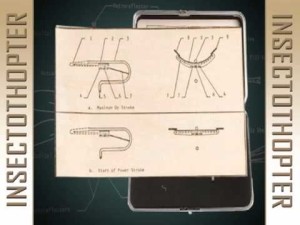When New York college students attended an antiwar rally in Lafayette Square they were convinced they saw small flying machines that were “definitely not insects” hovering above.
Bernard Crane, a Washington Lawyer, saw them too and said he had never seen anything like them in his life.
These sightings are among a group of sightings occurring in Washington and New York.
Dragonfly Drones in Flight
- By David Hambling
- 10.29.07
- 9:00 AM
More than a few people were skeptical, when the Washington Post picked up on our story about robotic dragonfly spies. The paper quoted eyewitness accounts — but failed to find any agency who would admit to using this type of micro air vehicle.
The FBI said they didn’t have one. Homeland Security wouldn’t comment. Neither would the CIA, whose previous robo-dragonfly effort in the 70′s was shelved due to its inability to handle crosswinds. It can now be seen in their online museum*. DARPA said they were interested in the idea but still working on it.
“If you find something, let me know,” Gary Anderson of the Pentagon’s Rapid Reaction Technology Office told the Washington Post reporter.
No wonder the Post ended up with an arched eyebrow. However, if they don’t think there are operational, camera-carrying micro air vehicles that look like dragonflies maybe they should take a look the video below.
Or check out the at some of the impressive footage of the DelFly II, a craft built by a team at the Delft University of Technology. This video includes some footages from the DelFly’s camera; there’s more video here and here.
Bart Remes, Developer of the Delfly, explains the unusual approach in building it. First you get your micro air vehicle working, then you make it smaller. And smaller.
“We start with a system that works (DelFly I), but which on has only forward flight, and make it smaller and better. DelFly II is smaller and more robust, has longer flight time, is able to hover, take off and land vertically, can even fly backwards. It can fly against the ceiling and walls without crashing – all this with a camera on board, so it is a useful platform.”
The next stage is DelFly Micro with a ten-centimeter wingspan
(pictured) which is already in development. This will be followed by
DelFly nano with a wingspan of just five cemtimetres. Miniaturising the flight system is not necessarily a problem – it’s the rest of it.
 “Developing the electronics, battery, camera, controls – that’s the hardest part,” says Remes.
“Developing the electronics, battery, camera, controls – that’s the hardest part,” says Remes.
He also has experience of flying the craft in wind, and finds that it is not the show-stopper that many people assume.
“Flying outdoors is no problem. If the wind is higher than the max forward velocity, you float with the wind like insects do to go from one spot to the other. DelFly II is a inherent stable platform so flying outdoors with gusts is no problem – if you stop steering DelFly
II will simply assume a stable position.”
It’s robustness means that impacts with obstacles or the ground will not damage it, which should mean that crashes are not a problem. The
DelFly II has a maximum speed of 15 meters/second — over 30 mph — and an endurance of at least 15 minutes.
It won’t just be used for spying on people. Remes suggests that it could be used to locate victims in collapsed buildings, or with a chemical sensor it can track down airborne pollution.
Perhaps there is nothing as advanced as DelFly in the US – in which case DARPA, the Rapid Reaction Technology Office and rest should come and talk to the DelFly team.
* I suspect the CIA may not have dropped the idea entirely. At a
Christmas party thrown by the CIA’s Office of Technical Services in
2000, Wired reported on a number of gadgets teasingly on display, noting “A dragonfly ornament’s wings move at hummingbird speed …”
Today, this science fiction vision is within the realm of reality.
